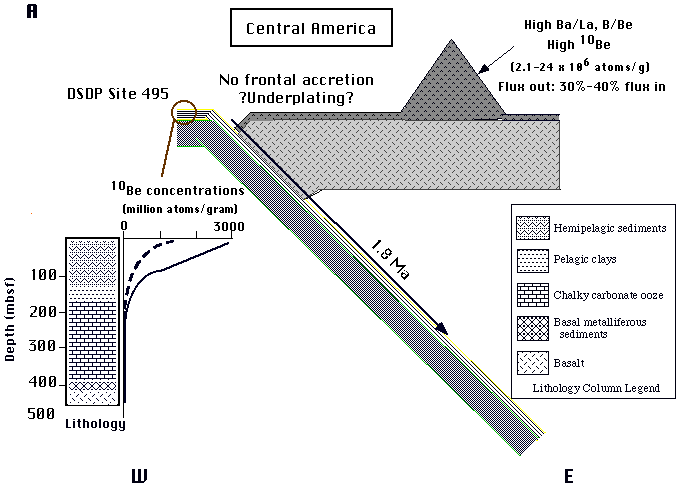170 Scientific Prospectus




Figure 4A. 10Be (half-life = 1.5 m.y.) concentrations and lithology vs. depth (data from Zheng and Morris, unpubl. data) at DSDP Site 495, offshore of Guatemala. The solid 10Be profile emphasizes the high concentrations of 10Be measured in near-surface sediments and the exponential decay to unmeasurable values at about 200 m (approximately 12 Ma). For the volcanoes to contain 10Be, more than 90% of these uppermost sediments must subduct to the arc source region. The total amount (or inventory) of 10Be in a 1-cm-by-1-cm sediment column = 13.2 x 1012 a/cm2. The 10Be inventory is calculated by integrating beneath the solid 10Be-depth curve shown in the graph. The dashed curve on the graph indicates the distribution of 10Be in the sediments after correcting for radioactive decay (10Bcorr = 5.7 x 1012 a/cm2) during the roughly 2 m.y. required to subduct the sediments from the trench axis to a point beneath the present volcanic front. The bulk atom 10Be/9Be ratio = 460 x 10-11 . This ratio is averaged for the sediment column and uses the decay-corrected 10Becorr concentration above and the total 9Be abundance. (See Brown et al., 1992; Tera et al., 1986; Monaghan et al., 1988; Morris and Tera, 1989; Morris et al., 1990; and Morris et al., in prep.; for discussion of the 10Be systematics and results from volcanic arcs and oceanic sediments). B. The equivalent diagram for Costa Rica, showing the approximate age
depth-lithology relations in the incoming sediment column. The absence of 10Be in the volcanoes indicates that the uppermost part of the incoming sediment is accreted and/or underplated. The column labeled "hypothetical 10Be conc. for Site CR-2" shows the distribution of 10Be concentrations (curved lines) expected with depth if the intraprism reflectors (horizontal lines) are gently folded décollements ("D"). The age of the packets decreases with depth, but the sediments within a packet are youngest at the top. The 10Be concentrations at proposed Site CR-2 will be at measurable levels if the sediments are younger than about 12 Ma. An absence of 10Be at proposed Site CR-2 implies older ages, which is consistent with episodic erosion or subduction erosion as discussed. The base of the underplated hemipelagic sediments is ~6-11 Ma, and the base of the carbonate is ~24 Ma. Stratigraphy for Costa Rica is inferred from seismic stratigraphy (Shipley and Moore, 1986) and by analogy with DSDP Site 495.